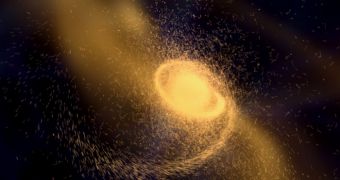Astronomers at the Stanford University say that only 4 percent of all the galaxies in the Universe have neighbors, like the Milky Way does. Our galaxy has at least two dwarf galaxies as companions, but it may also feature other, yet-undetected neighbors.
Throughout the Universe, this is a fairly rare situation, investigators say. In the study, conducted by Stanford astrophysicist Risa Wechsler, it was found that only a small percentage of all galaxies have neighbors. Most are spaced pretty far away from each other.
According to the study team, the work was conducted in order to determine how our galaxy fits into the broader, cosmic context. Wechsler says that such studies could help us determine whether the Milky Way is typical, or if it's formation patterns were unique.
In order to carry out the investigation, researchers had to analyze a large number of other galaxies, that were similar to our own as far as luminosity goes. Another factor the researchers checked for was the distance these galaxies were from other, equally-luminous celestial structures.
The main conclusion was that only 4 percent of all galaxies tend to have close-orbiting companions, such as the Milky Way's Large and Small Magellanic Clouds. Details of the research appear in the May 20 issue of the Astrophysical Journal.
Data used to carry out the analysis were collected from the Sloan Digital Sky Survey (SDSS), which covers millions of galaxies. A series of three research paper is scheduled for publishing, and this study is the first of them.
The SDSS is the most extensive survey of the optical sky performed to date. It is partially funded by the US National Science Foundation (NSF), and it's currently in its eighth year of operations. Some 25 percent of the sky was covered by 2011.
The 3D maps produced thus far contain more than 930,000 galaxies and 120,000 quasars, but the Stanford team only focused on 20,000 galaxies for this research. “This is an excellent example of data-enabled science,” explains Nigel Sharp.
“Comparing the 'fake' and 'real' Universes is how we discriminate between successful and unsuccessful theories,” adds the expert, who is based at the NSF Division of Astronomical Sciences (DAS).
“This work interconnects three of the four legs of science: theory, observation and simulation, for a powerful scientific result,” he goes on to say. Ultimately, these studies could lead to a better understanding of how the earliest galaxies appeared and developed.
“The combination of large surveys of the sky like the SDSS and large samples of simulated galaxies provides a new opportunity to learn about the place of our galaxy in the Universe,” Wechsler adds.
“Future surveys will allow us to extend this study to even dimmer satellite galaxies, to build a full picture of the formation of our galaxy,” she concludes.

 14 DAY TRIAL //
14 DAY TRIAL //